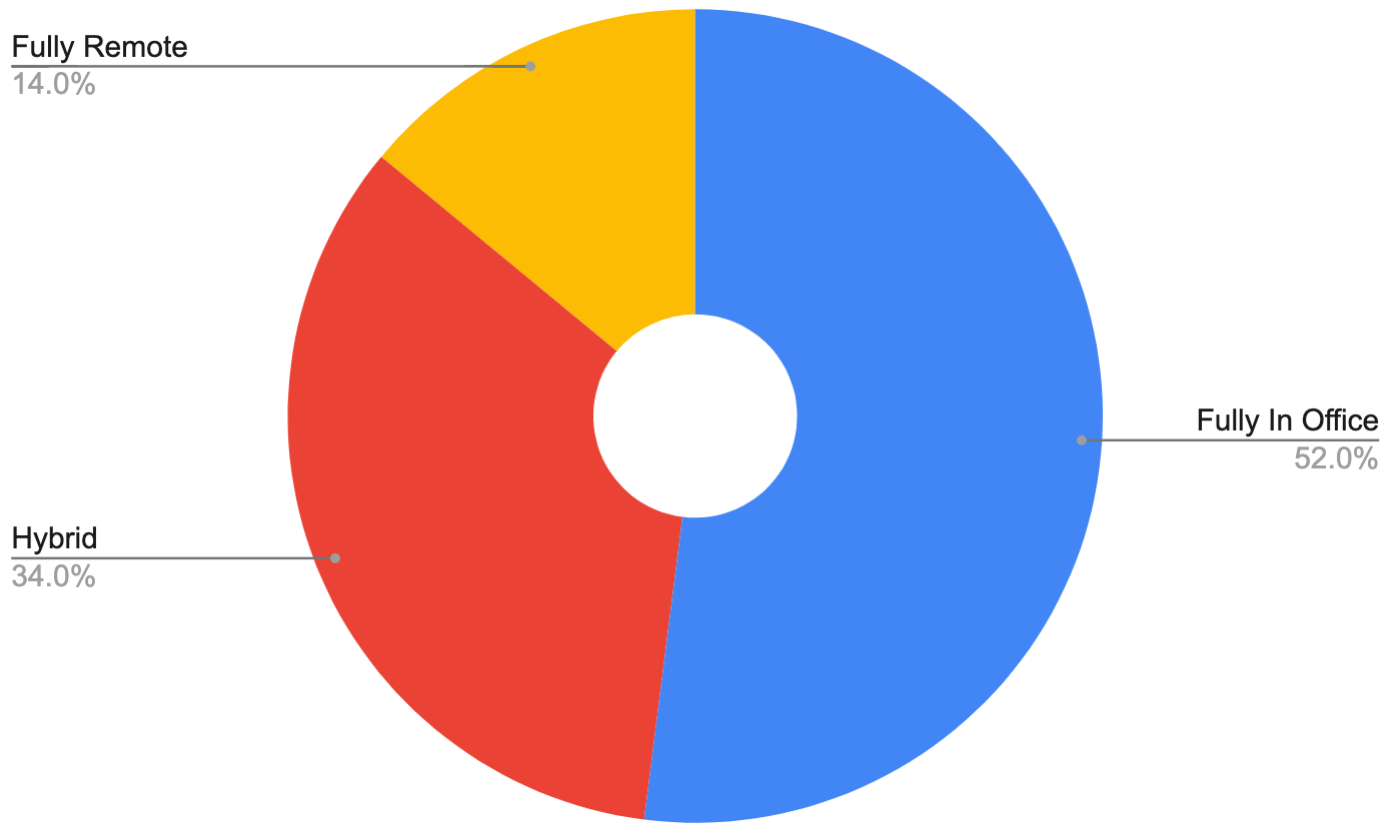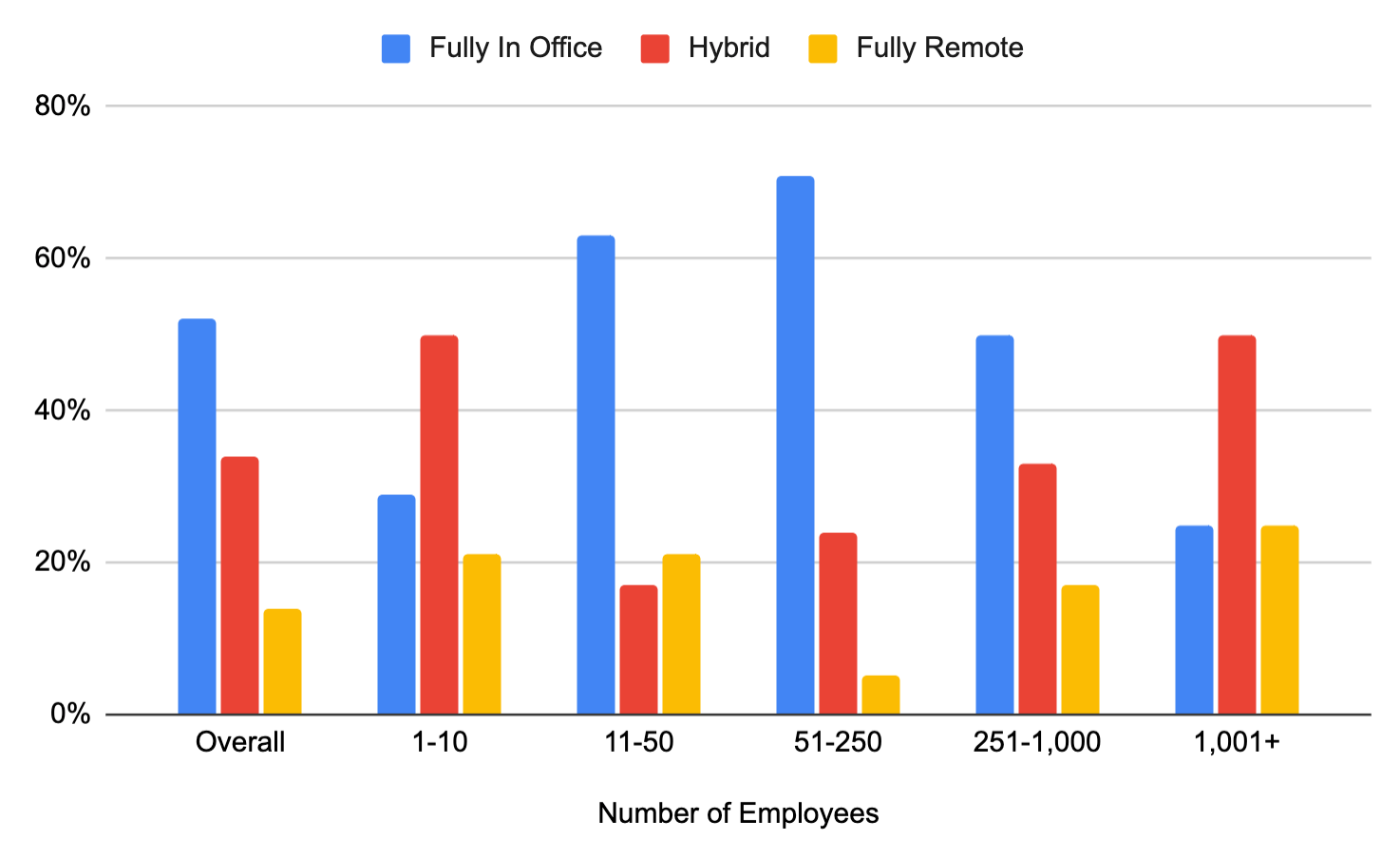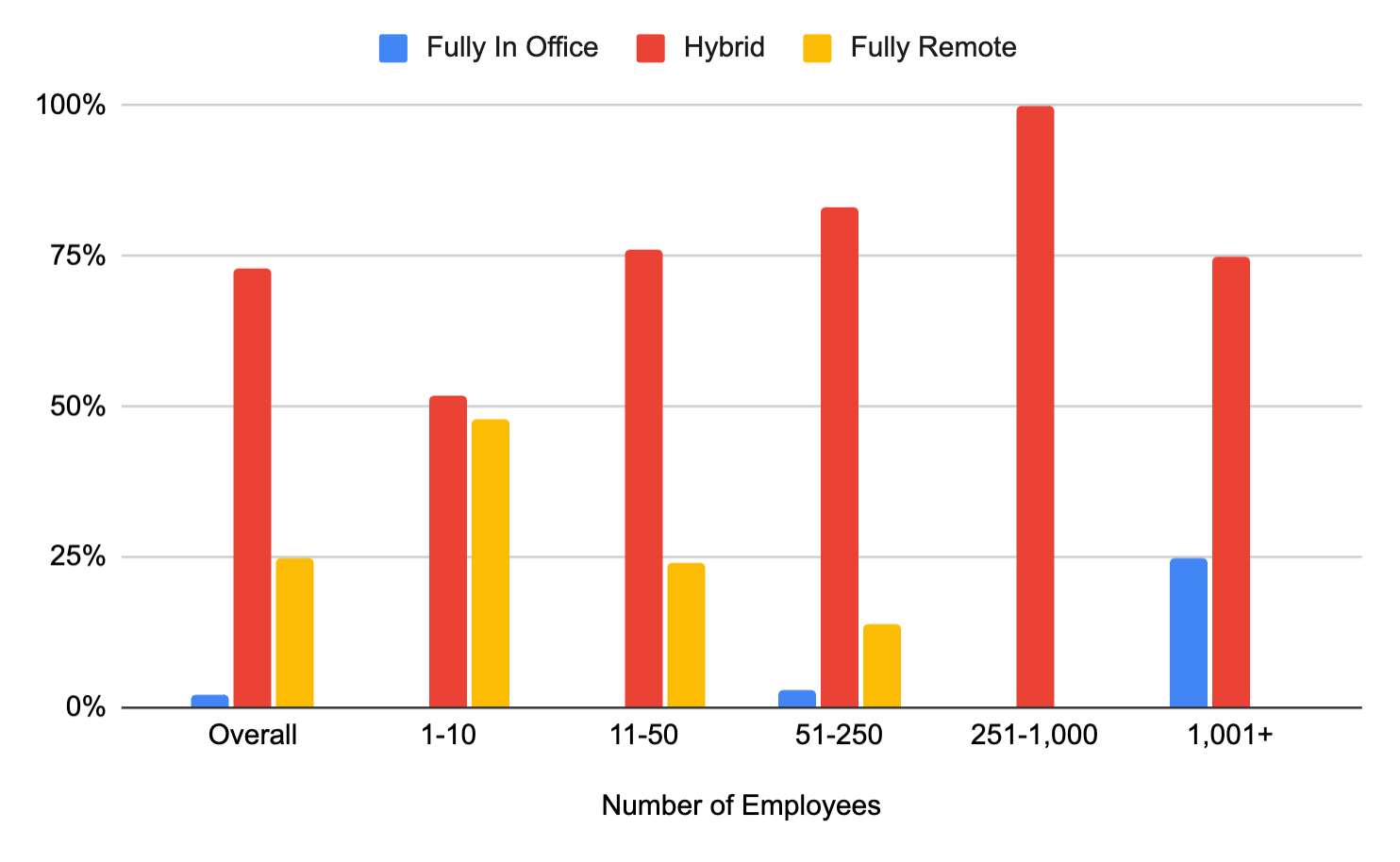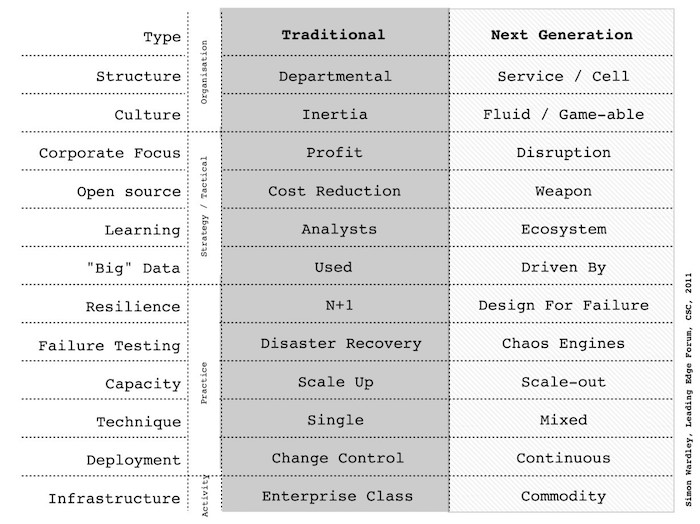At our Spring 2021 Conference in April the future of the workplace was, unsurprisingly, a hot topic. We had two important keynotes on the theme (subscribe to get notified when they’re published), various breakout sessions, and innumerable conversations.
We took the opportunity to poll our attendees on their experiences, challenges, and plans for their future workplaces and work environments.
The results were exciting and not quite what we expected. In this post we’re publishing the full results as well as our own analysis and take on them.
You can also download a copy of this report as a PDF for easier sharing.
1. Background
Life has changed. Rapidly. Though this change has been predicted for a long time, the last year has accelerated the inevitable at a pace few could expect. There is no doubt that the future workplace will look very different to the one of eighteen months ago.
However, according to recent research from the University of Chicago:
Total hours worked increased by roughly 30%, including a rise of 18% in working after normal business hours. Average output did not significantly change. Therefore, productivity fell by about 20%. Time spent on coordination activities and meetings increased, but uninterrupted work hours shrank considerably. Employees also spent less time networking, and received less coaching and 1:1 meetings with supervisors.
Source: https://bfi.uchicago.edu/wp-content/uploads/2021/05/BFI_WP_2021-56.pdf
So we’re doing more hours and getting less done? That’s not what a lot of us hope the future of work holds. Software companies, and BoS participants in particular, have often been at the forefront of major changes including remote working.
But the objective is usually to be more effective, provide a better service, and create more culturally sound organisations. If the accelerated pace at which we’ve adopted remote working comes at the heavy price of a 20% reduction in productivity its worth taking stock of where we’re going and how we’re getting there.
2. The Survey Questions
We polled attendees at our recent Spring Conference and subsequently shared the link to a wider audience. We asked some simple questions:
- Number of employees
- Pre-pandemic, was your company fully in the office, hybrid, or fully remote?
- In five years, do you expect to be fully in the office, hybrid, or fully remote?
- Do you have a “back to normal” strategy?
- What is the worst thing about being fully remote?
- What is the best thing about being fully remote?
- What do you see the biggest challenge in the workplace of the future?
Our final sample size was 113 contributors, all from software organisations. Results, anecdotes, and commentary are below.
3. Results: The Numbers
3.1 Pre-Pandemic Office Set Up
The majority of the respondents were working in fully-in-office setups pre-pandemic.

No great surprises but if you look at the responses by company size, it gets interesting.
Although smaller, earlier stage companies are often viewed as innovative, agile, and forward-looking, we were surprised that so many in this size range were fully office based, even in a group as thoughtful as BoS attendees. While the sample size of larger companies was small (more below), we were surprised that even at a company size of 11-50 and 51-250 employees, over 60% of respondents were located in an office. (See below.)

This is perhaps a reflection of the idea that there is value in bringing a team together as a company forms and starts to develop a mission, culture and shared understanding of the goal of the business.
3.2 Post-Pandemic Expected Office Setup in 5 Years
Is this a good time to short commercial property developers? Maybe not so fast.

Only about 2%, (two out of all replies), were expecting to be fully back in the office. Almost three quarters of people expect to be hybrid working, more than double than before. And while for some, remote is the future, it doesn’t seem to be the only future, or perhaps more accurately, the future is probably not fully remote.

The big change from before, is in the way that companies of between 11 and 250 employees view the workplace. Remember that pre-pandemic, over 60% of both segments were fully office based. Their future is hybrid, not fully remote. In fact, companies in the 51-250 range, there are fewer companies expecting to be fully remote post pandemic than before.
That seems to indicate that while most companies don’t expect to be fully back in the office, they will still need spaces where they can work, some teams can be located etc. The nature of the spaces might change considerably.
3.3 Do you have a strategy for back to the workplace?
The answers split almost evenly between No, Yes, Too early to tell.

Looks like we are all trying to work it all out.
4. Results: Anecdotes
4.1 What is the worst thing about being fully remote?
Aside from the odd outlier (eg, having my activity monitored remotely – what were they even doing at BoS?!), most of the bad things were probably predictable.
The top four things cover over 80% of answers.
- Lack of Connection – almost half
- Lower Productivity/Collaboration
- Home/Work Separation
- Feeling Isolated or Ignored
These responses are typical…
| I found myself feeling forgotten. It’s not that I didn’t have enough work, I just wasn’t sure people remembered I existed and that I could be a participant in certain conversations. |
| Isolation |
| Loss of interaction with colleagues and all that sparky serendipity. |
| Hard to separate work from home time |
| Kids under my feet, lack of variety |
| I miss people and you miss a lot of incidental chats about things, both work related and not. And being able to just turn to a colleague for an opinion or to talk through an idea. Oh and being stuck in the same room everyday. And fewer places to lunch. I could go on…. |
| Lack of face to face interactions made many work tasks much harder |
| Lack of human connection in the team. It’s easier for minor conflicts to grow |
| Much harder to build trust while being fully remote. So hard changed and moves are harder. |
| Lack of productivity due to personal responsibilities during Covid. Losing some team culture. |
4.2 What is the best thing about being fully remote?
Aside from the odd outlier again (ie, the one that said having activity monitored remotely – said the best thing was leaving that company and working somewhere that understood remote!), most of the good sides fit into three categories.
- More freedom/flexibility/family/personal time
- No commute
- Better productivity
For companies that value outcomes over outputs, a remote workforce can benefit from a higher degree of flexibility and freedom to organize themselves.
4.3 What do you see the biggest challenge in the workplace of the future?
This is where things are most interesting…
There were fewer people than we expected who mentioned issues like having a good work from home set up, mental health at home, and the fear that they would be driven back into the office against their will.
Many people talked about the challenges of remote and asynchronous work when it is new to some and not to others. Another common response was how to navigate the politics of the the new workplace in the short term, many mentioning things like vaccinations, masks, and employee/employer rights.
By far the largest group of issues however came from the category of managing a hybrid environment. These are some representative responses…
| A hybrid future feels likely, in which case there’s be big communication and inclusion challenges for hybrid teams. |
| A two speed career progression dependent on ability/willingness to be in a physical office. If senior management are all in the office most of the time, then those who work remotely will be (or at least feel) disadvantaged. This will be driven from the top of the organisation. |
| As remote becomes more commonplace, there will be a difference in how remote workers vs in office ones are treated and able to do their work. |
| Balancing the best of in-person and remote while creating an equitable workplace. |
| Bonds between teammates in office and remote |
| Communication |
| Effective tools for hybrid (some in office / some remote) collaboration |
| Establishing a strategy or plan also have our culture not be watered down |
| For us in particular, decentralizing will be difficult. Historically most of our employees have been in one location. We’ve recently started bringing on more and more people from across the country as remote workers, but the company still runs and schedules events with a heavy bias towards that initial office. |
| Getting the balance of remote and in office right so we get the benefits of both |
| Good managers |
| Having a cohesive culture with a group that has never been in an office together for anything more than a visit. |
| Having an owned space for ad hoc meetings. |
| How to satisfy the needs of different people. |
| Hybrid in small companies where if just a few people change their locations or habits it dramatically shifts the balance and atmosphere. |
| I think as a large number of companies choose hybrid, the next management issue is going to be what to replace “people in chairs” with. Many people use that as a proxy for whether they’re getting productivity from employees (plus other “easy button” issues that now they have to address more clearly, like how communication occurs, the usual remote coordination and communication issues, etc) |
| If hybrid, how do you not disenfranchise those who are not in the office. How do you ensure they get included into decision making in an equitable fashion. There would seem to be tension between the richer collaboration in person offers, and the desire for flexibility and work-from-wherever that hybrid offices afford. |
| Incorporating multi-generational workforces. We saw the challenge starting when millennials joined the workforce, and the disconnect between how our parents told us to find and keep a job vs. the reality we experienced, and I think that divide is going to continue to grow now that gen-z is coming in. With boomers choosing not to retire and wanting to work the way they always have, and gen-z nearly expecting to be able to work remote and use chat apps and productivity tools without email, there’s potential for a lot of friction in some workplaces. |
| Maintaining productivity and team engagement while working hybridity/remotely |
| Managing disparate views within the organisation. |
| Staying truly connected. |
| Striking the balance to get enough face time. |
| The challenge will be more companies that historically required people to be in offices, attending long drawn-out meetings. These will have to adapt. Similarly the workforce will have to adapt and it is already interesting to see with new hires (out of college for example) the ones who can deal with working remotely and growing/learning remotely vs. those who need handholding.What we are seeing in our field though is a much bigger emphasis on mental-health and balance. |
| Transitioning the workspace to shared versus dedicated. How much changed to meeting space and how many dedicated desks. What percentage of time in the office. Importance of company socials. |
5. BoS Commentary
Remote is not replacing the office, hybrid is replacing the office.
Clearly, there is a very high expectation that a hybrid workplace is the future. Almost every company that was fully in the office expects to have a hybrid in five years’ time. Perhaps more surprisingly, the percentage of companies at the 11-50 size range that expect to be fully remote in five years time, has not grown significantly: 21-24%
We think that the reasons for this are that even some remote companies have discovered some of the benefits of having an office, or place to meet people. We’re also seeing a large number of people who can see significant benefits and pitfalls of a fully-remote set up.
How do your run a hybrid business?
The biggest fear about the challenges seem to stem from how you operate a hybrid business, not a fully remote one. From employee recognition, hiring, maintaining connections, ensuring that remote and on-premise teams are recognised and rewarded fairly, there’s a rat’s nest of potential issues that make the next steps towards the future workplace challenging.
Over the years, many speakers at BoS have talked about their experiences with remote work. One thing that comes up again and again, is the challenge of managing a hybrid set up. In many cases, there were conscious adjustments, tweaks, to working practices, that made a difference – in the case of FogCreek for example, the idea that if one person was in a meeting remotely, everyone was, even when all the others were sat in the same room.
Is hybrid the worst of both worlds?
Others found a hybrid set up too difficult to manage – Joel Gascoigne, co-founder of Buffer – shared a decade ago, how Buffer closed their one office and did away with the ‘office perks’ – to keep everyone on the same level. Not being in the office should not be a disadvantage to anyone if you are a remote first company.
For many remote companies, there is a sense that you are either remote, or not. The hybrid model does not work.
Perhaps one of the biggest challenges that need addressing for hybrid setups will be the issues around employee recognition, career advancement and the potential for companies to have two ‘leagues’ of employees, the visible and the invisible.
Where are we now
- A period of enforced remote work for all companies has disrupted existing practices and forced a change in the way companies think about their businesses.
- Some businesses will fall back to their old ways as soon as they can. They are unlikely to be the stars of the future.
- Others have learned new ways of thinking about work, the workplace and how teams work together effectively.
- There are plenty of challenges to work through to make hybrid approaches work, but they will be solved by the companies that have shifted their mindset over the past year.
6. Further Reading (and Watching)
Simon Wardley has been thinking about the future of the workplace for decades. His recent article, an update of one from ten years ago, is well worth a full read.
His findings (based on two surveys a decade apart) really help you understand some of the drivers of change that have been present for a long time before Covid reared its ugly crowned head.
Ten years ago he identified what he saw as the key differences in behaviours between traditional and next generation companies.

And his updated view of the next next generation companies:

The first difference between traditional and next generation companies is their view on how work is achieved, the future of work is…
- Driven by procedures and office first in traditional companies
- Driven by guiding principles in a remote first environment in the next generation.
Steven Sinofsky has an excellent thread which synthesises these two thoughts with a bit of history thrown in:
“Debates over work from home v hybrid v HQ are becoming increasingly polarized (duh). It seems either one gets it, or not, with little room to disagree. There’s a reason for this and it is rooted in how disruptive forces take hold.”
Steven Sinofsky
Learn how great SaaS & software companies are run
We produce exceptional conferences & content that will help you build better products & companies.
Join our friendly list for event updates, ideas & inspiration.